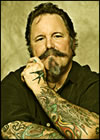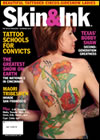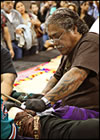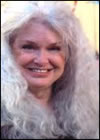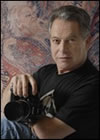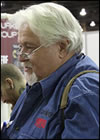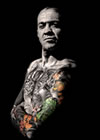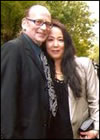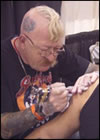|
|
|
|
|
Tattoo Chronicles << 101 Most Influential People in Tattooing << #70-#61 |
Top 101 Most Influential People in Tattooing
The ten people on this list have affected the course of the international tattoo scene as much by their personalities as their obvious talent. All of these ink world celebrities have attracted notoriety, some through their art and others with their words. Some are outspoken, others communicate graphically. In each case, the people on this list, eight men and three women, have a distinct personality, an unmistakable style that is stamped indelibly on their work. But that’s what tattooing is all about, isn’t it? Bringing the person who dwells deep inside us into the light. But when all is said and done, the world of tattoo would be quite different without these charismatic artists and their extraordinary contributions. —Bob Baxter  |
|
70. Uncle Tim Heitkotter (www.uncletimtattoo.com) built his reputation at his shop, Studio 13 Tattoo in Salinas, California. Always known for his solid lettering and traditional tattoo designs, Uncle Tim traveled back and forth between the California coast and San Francisco, maintaining close ties with Bay Area artists Bill and Junii Salmon and, his dear friend, the late Erno Szabady. Not one to stay in one place, Tim experimented with tattooing in various small, secluded towns on remote tropical islands (San Juan Puerto Rico, St, Maartin and Grand Caymann), and, finally, in 2005, packed up his belongings and relocated to the island of Kauai in Hawaii. Opening a two-station shop in a shopping center in Ching Young Village, a stone’s throw from the mystical beachfront of Hanalei Bay, Heitkotter has established himself as one of Hawaii’s and the industry’s foremost tattoo artists, taking the Mexican sugar skull to new heights, by adapting it to Polynesian themes and significantly raising the bar on a genre that has, until Tim came along, been negatively categorized as “tourist tats.” An expert letterer, teacher and tattoo mentor, Tim’s hand-done alphabets, signage and “word” tattoos are second to no one. His past Lettering 101 columns in Skin&Ink magazine and, currently, his Artist Lettering Tips & Tricks at tattooroadtrip.com have become a indispensible reference for tattoo artists from Kauai to Kentucky. When asked for his bio, here’s what Tim came up with:
Just like his tattoos, Tim’s biography is clear, clean and no bullshit. He knows a lot, gives good answers, helps people be better artists and is one of the best lettering guys in tattooing, right up there with Henry Goldfield and Jack “Fuckin’” Rudy. And you can’t get much better than that. |
|
69. Mary Gardner (mary@tattooroadtrip.com) earned her stripes in the tattoo world the hard way, face-down on a tattoo table, as Madame Lazonga drilled full-blooming orange poppies into her back for nearly fifty excruciating hours. An artist, quilter, tile maker (she designed, manufactured and installed the Moroccan tile work at Steve Wynn’s Aladdin Hotel in Las Vegas), gourmet cook and professional singer (Scottish to the core, she was, among other things, lead vocalist in a fifty-member, all-black gospel group), Gardner wasn’t shy when it came to jumping, feet first, into the world of tattoo. Within a year, she toured the convention circuit, got a full sleeve by Robert Atkinson and Leo Zulueta and took on the job of Advertising Director for Skin&Ink magazine, a position involving a lot of hand holding and educating tattooists about building their businesses. “Tattooists don’t really understand about advertising,” says Gardner. “They think that, if they’re booked a couple months ahead, why advertise?” Mary was the one who changed a lot of people’s thinking on that subject. What with an infinite number of new tattoo shops, over a quarter of a million tattooists in the U.S. alone and a major recession, Mary has helped many a business owner understand how to survive the competition, build a presence in a tricky economy and flourish where others have failed. Married to Bob Baxter, Mary pitched a website concept to the publishers of Skin&Ink, back in 2009, but her insistence that an energetic Internet presence would boost magazine sales was summarily rejected. Thankfully, the seed was planted, and, when Baxter was let go as editor, after thirteen years at the helm, Mary’s website idea was the brilliant alternative. Dubbed tattooroadtrip.com, Mary’s brainchild has, in barely four months, established itself as “the new voice of the tattoo industry” and exceeded the readership that the print publication had accumulated after more than a decade. |
|
68. Petelo Sulu’ape (uli@hug.co.nz) is the brother of the late Paulo Sulu’ape, and, quite frankly, I really don’t need any other reason to include him in this list than that. Petelo is perhaps one of the most artful and talented hand-poker alive today, and his pe’a designs (the traditional male Samoan tattoo extending from waist to knee) are truly classic. What his brother gave to the world, as far as inspiration, charisma and just plain technique (at the time of his passing, he was focusing his life on teaching hand-poking to indigenous cultures throughout modern-day Polynesia), flows in Petelo’s veins, too. Especially the tattooing part. Unfortunately, Petelo is not Paulo, and his efforts to rekindle a gathering of artists in Samoa in the early 1990s was a dismal failure. The first such event, conceived by Paulo to celebrate the two-thousand-year history of Samoan tattoo art (commemorating the time the twin sisters Taima and Tilafaima swam from Fiju to Falealupo on Upolu, bringing with them the tapping sticks, the au and the sausau) was an amazing, unforgettable event, attended by nearly eighty artists from around the world. Petelo’s follow-up (conceived as a tribute to his late brother) was, unfortunately, chaos. His partnership with the local politicians and dignitaries fell victim to bad advice and desperately lacked his brother’s talent for organization and inspiration. Nevertheless, Petelo proudly carries on the tradition of hand-poking using the sticks, a fine example of which is proudly displayed surrounding my left ankle. There will never be another tattoo gathering to equal the one in the year 2000, but, as long as Petelo and his family practice the Samoan art form and pursue the goals initiated by his brother, the Sulu’ape name will shine like a star in the night sky, high above Samoa and to the southwest, above his brother’s final resting place, in beautiful Aotearoa. |
|
67. David Nestler revolutionized the way other artists think about drawing pinup girls. An artist in the mold of pinup legends Alberto Vargas and Gil Elvgren and, more recently, Olivia De Berardinis, Nestler showed, at an early age, that there was promise in hours spent drawing and doodling in class. With no real direction in sight, Dave enrolled in the Fine Arts and General Studies program at the University of Pittsburgh, which he quit after three years and enrolled at the Art Institute of Pittsburgh in the Visual Communications and Commercial Arts program. After graduation, Dave moved to Los Angeles to become a “starving artist.” But, after a few short months, work came more frequently. Soon Dave was working for the entertainment community, capturing the likenesses of recognizable people, a skill that kept him highly employed through the mid-’80s. About that time, a shift in the industry occurred: photography began to replace traditional illustration. All of a sudden, the movie posters and album covers Dave had envisioned creating were non-existent. So, Dave moved back to Pittsburgh and began working in the advertising industry, moving through the local and regional ranks of free-lance illustrators, working on national accounts. With the end of the decade approaching, his work appeared on regional covers for TV Guide and other national publications. On the recommendation from a photographer friend, Nestler attended his first Glamourcon, in the fall of 1995. Expecting to see the work of Elvgren, Joyce Ballantine and other artists of the past, what he saw was a collection of contemporary pinup artists such as Olivia, Jim Silke, Dave Stevens, Robert Blue and others, who had resurrected an art form that had laid dormant for years: pinups. For Nestler, this was his pot of gold at the end of the rainbow. It was then that his “Blonde and Gagged” series was born. Instant recognition and market-wide acclaim came quickly. Not since Sorayama’s sexy robot women has a continuing series of paintings made such an impact on an international scale. The amount of imitators and replications of the Blonde and Gagged-style is a testament to that approach. In September of 2007, Nestler teamed up with Skin&Ink magazine, producing the first of a series of seven memorable covers. But not just any covers. Nestler painted them, not with an airbrush, like other contemporary pinup illustrators, with a traditional camel-hair. Dave had clearly developed a one-of-a-kind style, one that set the art community on its ear. Nestler also authors a series of “How to Draw with David Nestler” columns that establishes hims as the ink industry’s premier graphic arts mentor, and, by offering to assist, at no charge, tattoo artists who want to ink Nestler pinups on their clients, one of the most respected “outsiders” to ever enter the inner sanctum of the tattoo artist. |
|
66. Shanghai Kate Hellenbrand (dameoftheword@aol.com) was a participant in the tattoo world’s very first convention, held at Sailor Jerry Collin’s digs in Hawaii, back in the 1970s. Fresh from a successful career in the advertising game, Kate left the corporate scene to join friends Mike Malone and Don Ed Hardy in a serendipitous juggernaut through the days preceding the current explosion of tattoo art in America. An outspoken critic of what she considers unethical tattoo practices and commercialization within the industry, Hellenbrand has turned out several publications about Sailor Jerry’s life and times and, relatively recently, tracked down Jerry’s widow, Louise, and brought her, for the first time, to the realization that her husband is an icon in the tattoo industry and that a myriad of products, including clothing, equipment and even a bottled rum use his name. Her husband being a teetotaler, this information was, of course, a major surprise for Louise. Quite vocal regarding the indiscretions done in the name of “making money,” Hellenbrand has been a columnist for Skin&Ink magazine and author of two Schiffer books cataloging Sailor Jerry’s tattoo stencils. She has also produced a self-published and individually-numbered manuscript, Tattoo Tales by Sailor Jerry Collins, which was written by the legendary artist back in the 1970s. Still tattooing, Shanghai Kate has worked at shops from Texas to Alaska, and, as one of the more colorful old-timers of the tattoo world, continues to make friends, influence people and, generally, cause a ruckus wherever she goes. What with the current rash of slick, high-profile TV stars and self-proclaimed celebrities hogging the stage, the tattoo world could definitively do with more authentic and outspoken characters like Shanghai Kate. |
|
65. Richard Todd (www.designsforbettergiving.com) a native Californian, earned his Masters of Fine Arts degree in publication design from California Institute of the Arts and, in his final year of studies, an L.A. Art Director’s Award. Working as the senior photographer at Mattel Toys for five years and UCLA’s Museum of Cultural History for nine, Richard started photographing tattoo art for the book The Marks of Civilization, edited by the late Arnold Ruben. While working on that project, Richard was introduced to the National Tattoo Association, where, since 1986, he has donated his time photographing contestants at their yearly convention. Todd was also senior photographer at International Tattoo Art magazine, for eleven years. With such a solid background, especially his early studies with legendary lensman Ansel Adams, Todd is, perhaps, the most technically grounded of all the current tattoo photographers, having mastered the demands of operating large-format cameras and handling commercial assignments for highly respected publishers such as Harry Abrams, Reader’s Digest, Rizzoli, Harcourt-Brace, Friedman Fairfax, Barnes & Noble publishers and the presses of the Universities of California, New Mexico and Washington. With a trademark no-nonsense work ethic, Todd has clearly brought to the world tattoo photography a level of professionalism and technical excellence unheard of before his arrival on the scene. |
|
64. Billy Tinney (800-454-8417) is the Editor and Senior Photographer of Tattoo magazine, a position that Billy inherited more from the biker scene than the world of ink. A big guy with a big beard and a big heart, Tinney has photographed the tattoo scene perhaps more than any other reporter. Splitting his time among assignments for tattoo, custom bike and hotrod publications, Tinney has filled the pages of Tattoo with studio and candid shots that consistently communicate the special energy and aura of the conventions he covers. A tell-’em-like-he-sees-’em Texan, Tinney was one of the most prominent supporters of Bernard Clark and I, back when our partnership was first getting started, in the late ’90s. Always sporting a big grin and an air of confidence, Tinney is easygoing and willing to impart helpful tricks of the trade, provide the latest newsworthy gossip or hand over a needed strobe-light battery or roll of film. An advocate of the “shoot everything that moves” photo coverage, Billy works hard at what he does, and consistently has long lines of conventioneers queued up outside his studio door. He churns ’em out, but that never diminishes his enthusiasm, squelches his tireless persona or fails to declare that, “if Billy’s here, God is in His heaven and this must be a show worth seeing.” |
|
63. Noon (noontattooart.blogspot.ca), from France, is one of the founders of the modern abstract minimalism movement that has rocked the tattoo world, during the past few years. With influences that reach from childrens’ scribblings all the way to Picasso, Noon brings across his message through childlike drawings that look effortless and infantile, but, somehow, retain the stamp of genius that is both entertaining recognizably his own. Others have tried to emulate his technique, but mostly fall short. Gaining inspiration from Picasso’s famous quote, “It took me five years to be able to draw like Michelangelo, and then it took me the rest of my life to draw like a child,”Noon sent me some digital photos some years ago, and I was stopped in my tracks. Even though I got flack from some of my traditionalist readers, I loved Noon’s little stick figures and published them every chance I got. Clearly not listening when the teacher told him to “color within the lines,” Noon insists that he is not an artist himself. “I am not comparing myself to Picasso. I am an illustrator on skin, more an artisan or skilled craftsman doing tattoos than an artist. I am just using the ideas of my customers and illustrating them.” From Troyes, a small town in the north of France, Noon has created his own place among the top roster of international tattoo art. Incessantly travelling, when he is not holed up in his country retreat in the woods outside Troyes (where he lives without electricity and running water), Noon attends conventions all over the world and does numerous guest spots in New York, London and Berlin, true hotspots of the tattoo art world. “I have to go where my customers are,” he says humbly. “I don’t have enough work in France, and it is getting less. Our movement has many ‘children,’ now, and, if people like to get minimalist tattoos, they can often find someone doing a similar style close to home. Noon and his friends Lionel (Out of Step) and Yann Black established the art of minimalist tattoos, in the late 1990s and early 2000s. Noon’s work was mainly based on lines just as a child would draw them. “Imagine a spider. In the eyes of a child, it is a circle, two dots as eyes and a few lines around it to make legs. That’s it. All the necessary information is there. It is not a perfect drawing, but it is spontaneous. I actually used the drawings from my little son as designs for tattoos. But now he is eleven years old, and the innocence is lost a bit.” |
|
62. Bill & Junii Salmon are tattoo’s star-crossed lovers. “Diamond Club, Bill and Junii Salmon’s legendary tattoo art studio,” as noted writer and photographer Charles Gatewood tells us, “perfectly illustrates the phrase ‘where the elite meet.’” Practicing Buddhists, Bill and Junii have been close friends with the Leu family Iron for over twenty-five years. Bill grew up in Troy, New York, where his parents wanted him to join the family dental business, but Bill was more into cars and music. He plays the saxophone, flute, and guitar. When he was twenty-two, he headed for California, hung out in Orange County for a while, then came to San Francisco, where he performed as a street musician and worked in a music store. “I wandered into Lyle Tuttle’s shop one day in 1974,” he remembers. I got my first tattoo from Pat Martynuik, “I was hooked. I’ve now been tattooed by over one hundred and twenty different people.” Influenced by artists Dean Dennis, Sailor Jerry Collins and Mike Malone, in 1984, Ed Hardy invited Bill to work at Realistic Tattoo. He met Filip Leu at Realistic. Greg Irons and Good Time Charlie Cartwright were also big influences. In 1987, Hardy brought Horiyoshi III and another tattooist, Horitoshi I, to San Francisco from Japan. It was a humbling experience, seeing tattoo work that sophisticated. And it was wonderful meeting a beautiful young woman named Junii, who was getting a full Japanese bodysuit from Horitoshi I (quite a momentous event for a woman, back then). It was love at first sight. Bill and Junii were married within a year. Becoming a respected tattooist in her own right, Junii’s classic Japanese designs are lush, sensual and altogether wonderful. Her kanji are exquisite. “If you want kanji,” admonishes Bill, “get it from a Japanese artist. Junii’s kanji are beautifully drawn, and the meaning is always correct.” As for Bill, his “trippy” 1988 tattoo, “The Electric Kool-Aid Acid Test,” showed the Mr. Kool-Aid pitcher, high and happy, glowing with psychedelic colors, an obvious reference to Ken Kesey, the Merry Pranksters and San Francisco’s 1967 Summer of Love. When I first met Bill and Junii, they were tattooing out of their elaborately decorated apartment, a few short blocks away from their current location, a few blocks up the street on Van Ness. Seems the landlord was uncomfortable with a busy tattoo studio in his building, so the Salmons opened, not without some trepidation, their first street shop, which, because of their longstanding reputations, has turned out quite successfully. With its richly decorated interior, the Diamond Club resembles a religious shrine. Near the entrance hangs a colorful banner painted by Junii, showing the goddess Kwan Yin holding the world in one hand and a tattoo machine in the other. The perfect symbol for these legendary ambassadors of tattoo art. |
|
61. Tennessee Dave James (sadly Dave passed away in 2013 - see memorial post) was a living example of how the tattoo industry looked about forty years ago. When I visited him, back in 2005, at his infamous shop, West Coast Tattoo, located in downtown L.A.’s Tenderloin district, Dave was packin’, and I don’t blame him. I would, too, especially after stepping over several inebriates sprawled across the sidewalk in front of his door. I would also carry a couple grenades. Tennessee Dave is definitely Old School. His famous outhouse tattoos grace the bodies of many a discriminating tattoo buff (including yours truly), and he is also one of the last, great, remaining tattoo storytellers. It starts to get fun when Tennessee gets wound up about his time working the Long Beach Pike with Bert Grimm, Lee Roy Minugh, Dave’s brother, Greg, and a raft of other historic artists, back in the day. Here’s an excerpt from “The Wit and Wisdom of Tennessee Dave,” circa 2005:
There ya go: Great writing, great history, great life. Tennessee Dave James—keeping the traditions alive, in word and deed. 
Tattoo Chronicles << 101 Most Influential People in Tattooing << #70-#61 |
|
|
|

